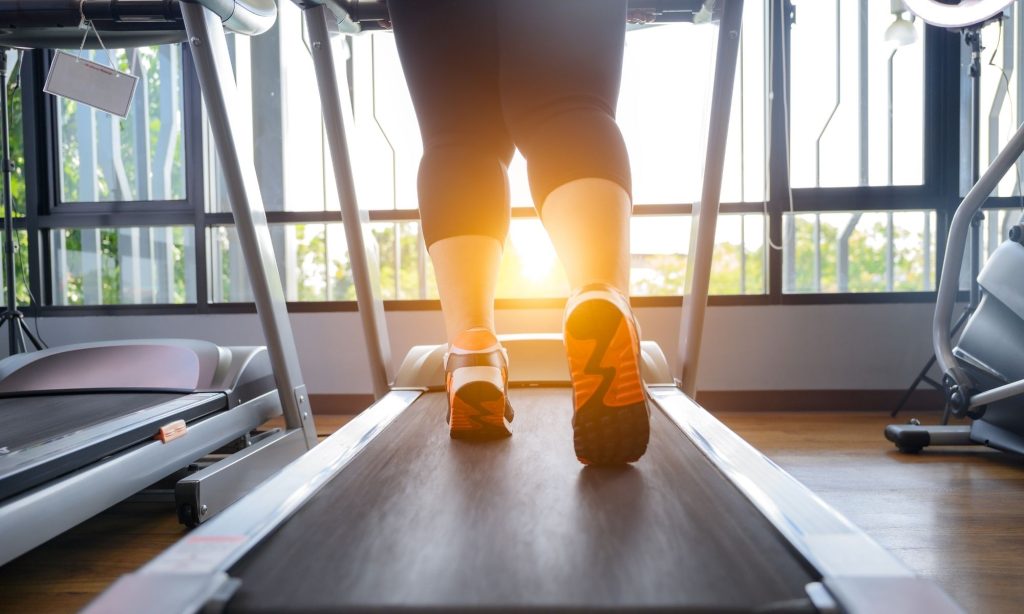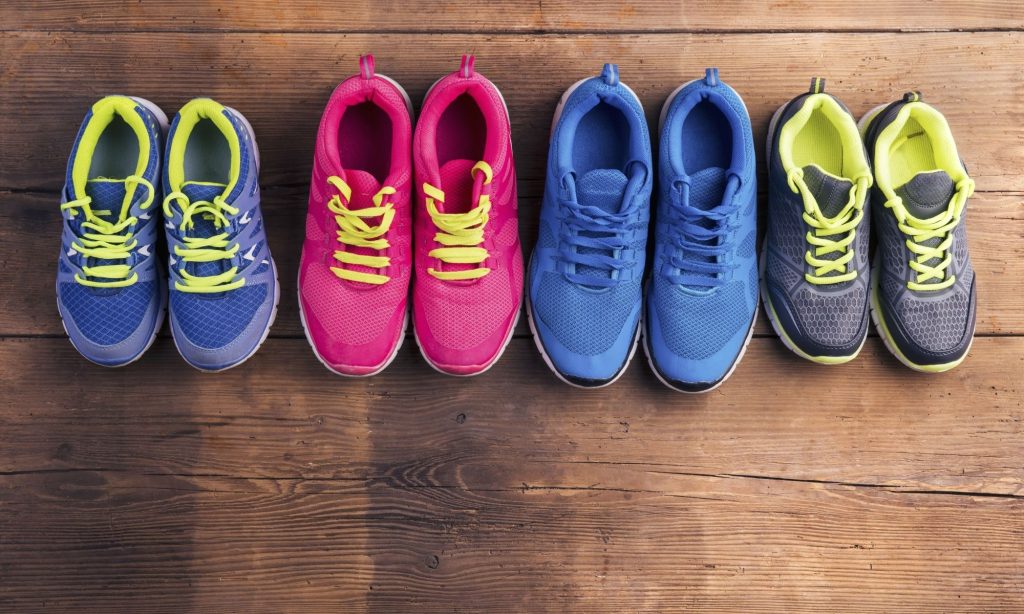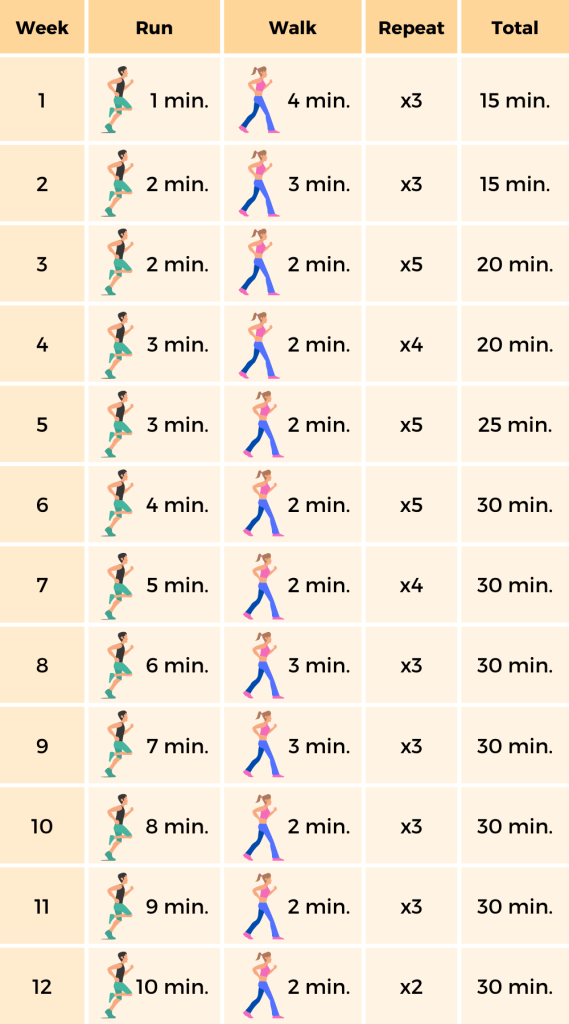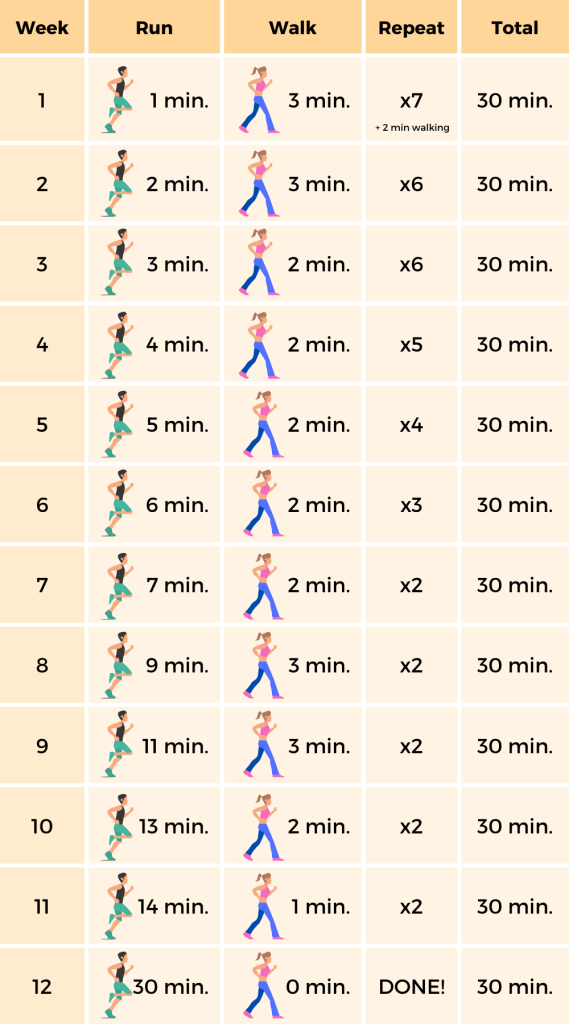You’ve seen people running—on the treadmill at the gym, on the trail, around your neighborhood, around the city, on vacation…pretty much anywhere and throughout the day. Maybe you have friends and family members who love to run. And you might’ve wondered what this running thing is all about. In case you’ve ever thought about taking up running, or maybe you’ve tried running and it didn’t quite work out, this blog post is for you.
When many people decide to run, they plan to run their entire chosen distance. On day #1. Because they’re going running, right? And runners…well, they run. And then, halfway through, or sooner, or later, they just can’t run anymore, and they decide running is NOT for them. Here’s the deal: While the desire to run is admirable, there are a few things you need to keep in mind in order to become a runner without hating every single minute while you’re pounding the pavement. Or the treadmill. Or the trail. Or wherever you’re running.
First of all, why would people even want to run? Here’s why…
The Benefits of Running

- Strengthens your bones
- Relieves stress
- Boosts your immune system
- Helps suppress your appetite for the rest of the day
- Helps with depression
- Lowers your risk of developing blood clots
- Lowers your blood sugar
- Helps you feel better and more confident
- Raises good cholesterol
- Increases lung capacity
- Helps you sleep better
- Improves your mood
- Running outside gives you an all-important dose of vitamin D + the opportunity to enjoy nature
- Decreases your risk of heart disease, breast cancer, and stroke, potentially adding more years to your life!
- It’s family-friendly—involve the kids!
- Helps you burn calories, which can contribute to weight loss.
Beginning running tips + tools
Here are three tips and some helpful tools to help you become a runner , including two programs that will work for anyone…Anyone!
Tip #1: Get some running shoes.

It’s time to go shopping for those running shoes, and you’re not going to go to a sporting goods store or a shoe store. You’re going to head to a running shoe store.
Why?
Unlike other types of shoe stores, running shoe stores are staffed by experienced runners who have been trained to help you find the correct shoes for your gait (how your feet land when you walk or run). Your gait might be neutral, or you might pronate or supinate, and it’s important to know your gait because if you supinate, for example, and you run in shoes meant for a different gait, you WILL get injured. That’s a promise.
To find a running store in your area, type “local running stores” into your favorite search engine. Happy shopping!
While some running shoe stores will manually evaluate you (watch you walk, etc.) which is totally fine, many can now evaluate your gait and foot using really cool technology, which makes finding the correct shoe for your feet much easier than in years past. The salesperson will then find several options for you to try on based on your evaluation, maybe have you run in them for a few steps, and then you’ll choose which shoes feel the best.
Here are some things to remember when deciding which shoes to buy:
- Ask the store about their return policy. Since you really won’t know if a pair of shoes will work for you until you run in them for a few days or more, make sure you can return them for a full refund even after you’ve worn them. Reputable running stores will have this policy.
- Don’t go by brand. Just because so-and-so likes a certain brand of shoe doesn’t mean that brand is right for you and your feet. Remember, it’s all about finding the best shoes for YOUR feet.
- Running shoes can be a bit pricey. However, when you divide that cost out over the months you’ll be running in those shoes, they’re a pretty affordable investment. And if you do settle for inexpensive shoes to save some money, which will most likely be poorly made and will probably be the wrong shoes for your feet, you’ll be spending time and money on the physical issues (knee, hip, back, foot, and more) that can result from wearing the wrong shoes. Remember, you’re not just investing in shoes, you’re also investing in your goals and in your long-term health.
- Running shoes do have a shelf life. A proven rule of thumb is to get new shoes every 300-500 miles OR every 4-6 months, depending on how often and how far you run. If you run in hot climates, you might have to get new shoes more since you’re literally “burning rubber” if you’re running on the road.
Tip #2: Find a running program

You can find numerous beginning running programs on the internet, and here are a couple we’ve put together for you so you can begin today (or as soon as you get your shoes 😉)! We have a program for true Beginners (those who are new to working out) AND for Running Rookies (those who are already working out but want to give running a try).
Beginner Running Program (for Those NEW to Working Out)

Running Rookie Program (for Those Who Already Work Out)

Choose the program that’s best for you and start running! And no worries if you need to switch programs.
Each program takes 12 weeks, which might seem like a long time. Just remember that the goal here is to gradually build up your distance and time running so your body can adjust in a way that helps you want to keep running and that will keep you healthy long-term.
Here’s one important thing to keep in mind: The first day of each new week will probably feel tough. That’s to be expected since you’re asking your body to do something new. So, if you start to struggle, just slow down a bit. You will get there! And you might be hesitant to begin a new week, thinking, “I just can’t do this!” Give it a try anyway. You’ll be surprised at what you and your body can do!
Once you complete your program, continue increasing your running minutes each week. You can run “straight” (no walking intervals), or you can include walking intervals (try 1-2 minutes). Do what works best for you and your goals! And even if you include walking intervals, you are still a runner. Many runners use intervals to allow them to run longer/farther overall, run faster during their running intervals, and to give their bodies a break (the walking intervals) throughout their runs.
Tip #3: Go running!

Before you take that first step, keep these tips and tools in mind.
Always Warm Up and Cool Down. An easy way to warm up is to walk for 5 minutes, then do some light stretching. Repeat this at the end of your run for your cool down.
The first 5 or so minutes will be tough. When you begin a cardio session, it takes your breathing a few minutes to catch up to the oxygen your body needs to keep doing that exercise somewhat comfortably (at least to the point that you’re not having a difficult time breathing), so that’s why pacing is so important! And don’t be afraid to slow down your pace for a bit until you can breathe easier. You can always pick up your pace later.
Watch your pacing. It’s so tempting to start out running too fast, and then after a few minutes, you’re done. Like, D.O.N.E. Done. And like we talked about above, if you find yourself struggling, slow down! Some experts recommend a 3:2 or 4:3 breathing pattern (breathe in for 3 steps, out for 2 OR breathe in for 4 steps, out for 3), which not only balances out the impact to your body from of each step, but counting those steps can actually keep your mind busy too. 😉
Go for time, not distance. Some days running will go better than others, and if you’re always comparing your distance from one day to another, it can feel pretty frustrating when you don’t go as far during your set running time. So, unless you’re training for a PR for a race, run for time most of the time. If you want to know how far you’re running, track your distance one day every week or two.
Increasing Mileage. Once you finish your 12-week program, don’t increase your TOTAL weekly mileage by more than 10% each week. Here’s an example: If you’re running 10 miles a week, then only increase your TOTAL weekly mileage by 1 mile. Increasing your mileage too quickly can lead to injuries.
Use an Interval App. The last thing you want to do when you’re running is to continually be looking at your watch to see if you can walk yet. And just like a watched pot never boils, a watched watch moves VERY slowly. You can find free and very low-cost interval apps that will tell you when it’s time to run or walk. If you like to listen to music or podcasts while you’re running, make sure the app you choose will work while your music/podcast is playing.
And here are a couple of other tips that are helpful for both running and your overall transformation goals:
Drink Your Water. We’ve said it so many times before, and we’ll say it again: Drink your water! Aim for ½ your body weight in ounces every day, and even more on running days to make up the water you lose due to sweating and working those muscles.
Eat Healthy Foods. You’ve probably heard this saying: “Abs are made in the kitchen.” The same is true for running: “Good—and even amazing—runs are made in the kitchen!” You can find lots of nutrition programs with a simple internet search, and we have some amazing nutrition programs in The Transform App! But no matter which nutrition program you choose, here are 3 things to keep in mind:
- Your plan doesn’t recommend a super low daily calorie count (1200 or less for women and 1500 or less for men).
- Your plan doesn’t exclude any food groups.
- Your plan includes an overall balance of protein, carbs, and fat—the macronutrients that are essential to healthy living, achieving your transformation goals, workout success, and running.
Want to learn more about macros + macro tracking? Download our FREE Macro Counting 101 eBook.
Cross train. No matter what your workout program entails, always Include resistance training, stretching, and other forms of cardio in your program. When you leave out one of these and/or run too many days a week, injuries (especially overuse injuries) can happen. Balance is the key to a happy life AND a happy running life.
If you need an awesome resistance training program, check out The Transform App! It has several workout programs—including a dance program, and we have both at-home and gym programs! Get your first 7-days FREE!
And here’s one final tip, and it’s an important one!
Embrace that you are now a runner! While it might be tempting to say, “I just jog a few times a week,” or “I’m not a runner—I don’t run races, or place in races, or run for miles at a time,” or anything else that you think “real runners” do, be aware that you’ve got a case of imposter syndrome. If you run, no matter your pace, or distance, or anything else, you’re a runner. You don’t have to check any boxes off a “real runner” list to claim being a runner status. So, enjoy this new part of your life, work running into your routine as best fits you and your goals, and run!
It's Time to Become a Runner!

With your brand-new running shoes, a program ready to go, and the tips and tools we’ve shared, once you take that first step, you are now a runner, and you’re part of a growing club with over 621 million members worldwide! And it’s a pretty awesome club to be a part of.
Happy running!


